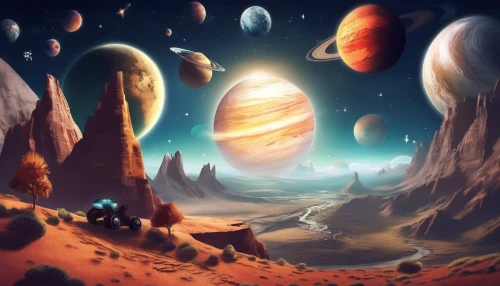
Exploring the Solar System: How Technology Has Enabled Humanity to Reach the Stars
From landing on the moon to sending rovers to Mars, technology has made it possible for humanity to explore the far reaches of our solar system. This blog delves into the remarkable technological advancements that have allowed us to study distant planets, moons, and beyond, paving the way for future space exploration.
Humanity’s curiosity about the cosmos has driven us to explore the unknown, and over the past few decades, our reach has extended far beyond Earth. Thanks to extraordinary technological advancements, we’ve managed to send spacecraft, probes, and rovers to nearly every corner of our solar system. These breakthroughs have allowed us to explore planets, moons, and even the outer edges of our celestial neighborhood. In this blog, we’ll take a journey through the technology that has made it all possible—from the early days of space exploration to modern-day missions that are pushing the boundaries of what’s possible.
1. The Early Days: Rocket Technology and the Space Race
The exploration of the solar system wouldn’t be possible without the development of powerful rocket technology. In the mid-20th century, the Space Race between the United States and the Soviet Union ignited a period of rapid technological innovation. The advent of multi-stage rockets like the Saturn V, which carried astronauts to the moon, demonstrated the potential to travel beyond Earth’s atmosphere.
On July 20, 1969, humanity achieved one of its greatest technological feats: the Apollo 11 mission successfully landed astronauts Neil Armstrong and Buzz Aldrin on the moon. The technology behind this mission included state-of-the-art computers, navigation systems, and the powerful Saturn V rocket, which remains one of the most powerful rockets ever built. This historic event set the stage for further exploration and laid the foundation for our understanding of how to navigate the vastness of space.
2. Probes and Satellites: Eyes in the Sky
While landing humans on the moon was an incredible achievement, the exploration of the solar system truly began with robotic probes and satellites. These unmanned spacecraft have been our eyes in the sky, venturing to distant planets and sending back invaluable data.
- Pioneers and Voyagers: NASA’s Pioneer and Voyager missions were among the first to explore the outer solar system. Pioneer 10 and 11 provided the first close-up images of Jupiter and Saturn, while Voyager 1 and 2 sent back breathtaking images of the outer planets and their moons. Voyager 1, launched in 1977, has since become the first human-made object to enter interstellar space, continuing to send back data over 40 years later.
- Cassini-Huygens Mission: Launched in 1997, the Cassini spacecraft spent 13 years exploring Saturn and its moons. It provided us with detailed images of Saturn’s rings and the discovery of liquid oceans beneath the icy crust of its moon, Enceladus. The mission was made possible by advancements in onboard computing, power systems, and long-distance communication technologies.
- New Horizons: In 2015, the New Horizons spacecraft gave humanity its first-ever close-up images of Pluto, revealing a surprisingly complex and active world. This mission highlighted how far technology has come, as New Horizons traveled over 3 billion miles to reach the dwarf planet.
3. Mars Rovers: The Red Planet Comes to Life
Mars has long captured the imagination of scientists and space enthusiasts alike. The technology behind the Mars rovers has allowed us to explore the surface of the Red Planet in unprecedented detail. These rovers are equipped with cutting-edge technology, from advanced navigation systems to robotic arms that can analyze the planet’s surface.
- Spirit and Opportunity: Launched in 2003, the twin Mars rovers Spirit and Opportunity were designed to explore the Martian surface for 90 days. However, Opportunity far exceeded expectations, continuing its mission for nearly 15 years and providing crucial data on the history of water on Mars.
- Curiosity Rover: Launched in 2011, Curiosity is still actively exploring Mars, equipped with advanced tools such as laser spectrometers and chemical analyzers. Its mission is to determine whether Mars once had the conditions to support life. The rover’s ability to transmit high-quality images and data from millions of miles away is a testament to the evolution of space communication technology.
- Perseverance Rover and Ingenuity Helicopter: The latest advancement in Mars exploration came in 2021 with the landing of the Perseverance rover. Equipped with more sophisticated technology, Perseverance is tasked with searching for signs of ancient microbial life. Accompanying Perseverance is the Ingenuity helicopter, the first aircraft to perform powered flight on another planet. This incredible achievement opens up new possibilities for future exploration.
4. Landing on Other Worlds: Touching Down on Comets, Moons, and Asteroids
Technological advancements have allowed us to land on distant worlds that were once considered unreachable. Robotic landers have been sent to comets, moons, and even asteroids, providing insights into the early formation of the solar system.
- Rosetta and Philae: The European Space Agency’s Rosetta mission made history in 2014 when its lander, Philae, touched down on a moving comet. This was the first time a spacecraft had landed on a comet, providing crucial data about the origins of the solar system.
- Hayabusa2 and OSIRIS-REx: Japan’s Hayabusa2 and NASA’s OSIRIS-REx missions successfully landed on asteroids, collecting samples and returning them to Earth. These missions are vital for studying the building blocks of planets and understanding the composition of early solar system materials.
5. The Future: Spacecraft and Missions Beyond
As technology continues to evolve, so does our ability to explore even deeper into the solar system and beyond. New missions are being developed that aim to explore distant moons, icy planets, and perhaps even send humans to Mars.
- Artemis Mission: NASA’s Artemis program plans to return humans to the moon by 2024, with the goal of establishing a sustainable presence and using the moon as a stepping stone for future missions to Mars. The development of next-generation spacecraft and lunar habitats is paving the way for long-term human exploration of other celestial bodies.
- Europa Clipper: Scheduled to launch in the 2020s, the Europa Clipper mission will explore Jupiter’s icy moon, Europa, which is believed to have a subsurface ocean. This mission could provide crucial data on the potential for life beyond Earth.
- Mars Colonization: With advancements in spacecraft, propulsion systems, and life support technology, plans for human missions to Mars are becoming increasingly realistic. Companies like SpaceX are developing reusable rockets and advanced spacecraft capable of carrying humans to the Red Planet.
Conclusion:
- The exploration of the solar system has been made possible by remarkable technological advancements, from powerful rockets and sophisticated probes to rovers and landers that have brought us closer to understanding our place in the universe. As we continue to push the boundaries of what’s possible, future technologies will enable us to explore even further, unlocking new discoveries and perhaps even paving the way for humanity to live beyond Earth.
- This blog delves into how technology has enabled humanity to explore the solar system, from early rocket-powered missions to modern-day rovers on Mars. It highlights the incredible innovations that have allowed us to study distant planets and moons, and what the future holds for space exploration.



0 Comments